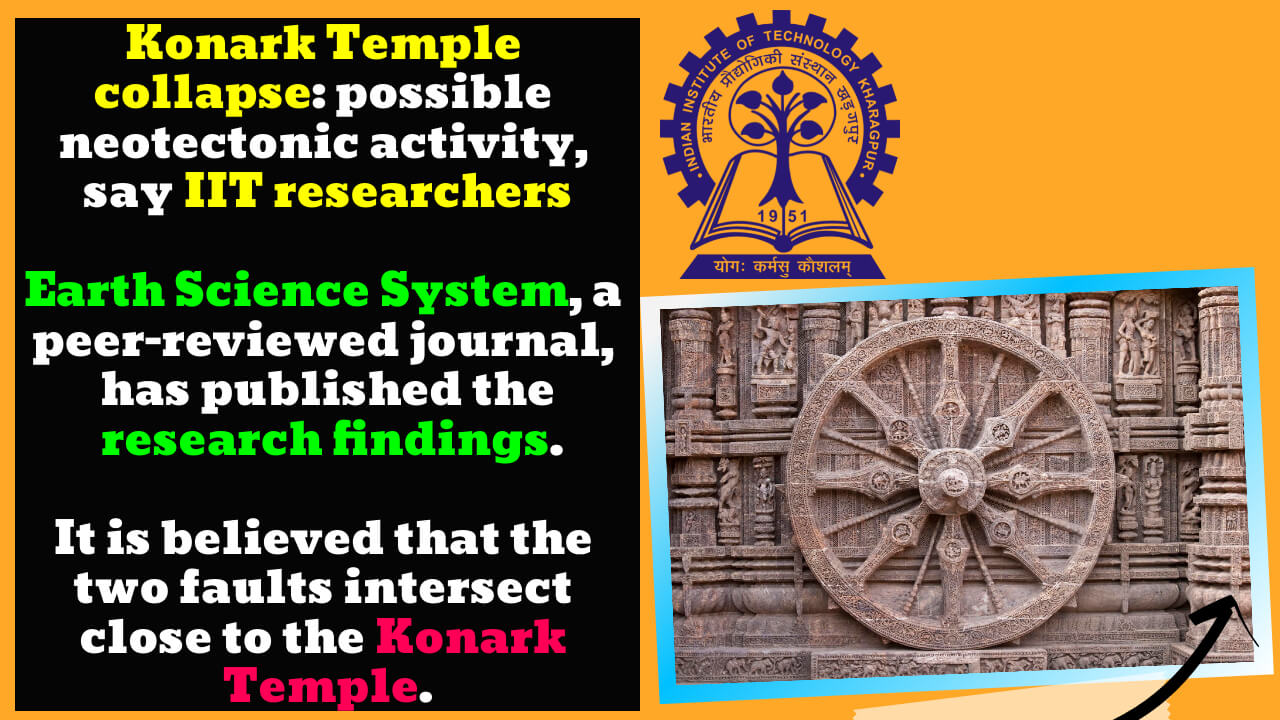Tectonic activity may have caused the 13th-century Konark Temple in Odisha to fall, say, researchers. It was built by Narasimhadeva-I of the Ganga dynasty between 1243 and 1255.
It is a huge temple to the Sun God. Neotectonic activity in this area may have caused the Konark Sun Temple to fall. The temple’s exact date and why it fell are unknown. The findings were published in the Journal of Earth Science System, which is a journal that experts have checked.
Key Highlight:
- The main temple in Konark, Odisha, may have collapsed due to neotectonics.
- King Narasimhadeva I of the Ganga dynasty built the temple in 1243-1255.
- The reactivation of faults that crisscross the Mahanadi delta’s basement is still causing tectonic activity along Odisha’s coast.
- The same team discovered evidence of the extinct Chandrabhaga River near the UNESCO site in 2016.
- Published in Journal of Earth Science System.
- The exact date and cause of the temple’s collapse are unknown.
- According to one theory, King Langula Narasimha Dev’s early death prevented the temple’s completion.
- Another theory holds that after Dharmapada’s suicide, the temple lost its sacredness and was abandoned by the faithful.
- The IIT team claims that the two faults intersect close to the Konark Temple.
- The Chandrabhaga river used to run near the temple.
The exact date and reason why the Konark Temple fell are unknown. Even though it is hard to say how long the temple has stood the test of time, there are a lot of different ideas about this.
There may have been some neotectonic activity that caused the main part of the 13th century Konark Temple in Odisha to fall, Indian Institute of Technology Kharagpur researchers say.
The researchers say that even though there are many different theories about how the main part of the temple fell, this is the first time that they have found scientific evidence that tectonic movement may have caused the temple to fall.
It was built by Narasimhadeva-I of the Ganga dynasty between 1243 and 1255. It is a huge temple to the Sun God. You should visit this place if you want to see something in the state’s east.
You might think that what you see now is just the Jagamohana (hall of meeting), but it’s part of the main temple. The main temple tower, known as Garbha Griha, which housed the presiding deity, has fallen. Only the ruins can be seen, and only the ruins can be seen.
There are a lot of different theories and ideas about how the main temple fell. Nobody could prove that any of them were true with the help of science. Our study looks at this old problem from a geological point of view. They say that neotectonic activity may have caused the temple to fall. William Kumar Mohanty, a geology and geophysics professor at IIT Kharagpur, said this:
After finding evidence of an extinct river near a UNESCO world heritage site in 2016, the same team did the same thing again. When the researchers looked at satellite images, they checked them against data from other places. This helped them figure out the path of the ancient river.
Because the fault lines that run through the Mahanadi delta’s basement have been reactivated, tectonic activity is still in Odisha’s coastal area.
The subsidence and uplift of basement blocks cause the river channels that flow through the coastal region to change shape as they move through the area. These tectonic movements are likely to have messed up any river flowing along the fault lines and may have caused many rivers to dry up, including the ancient Chandrabhaga River that ran north of the Konark temple.
“Low to moderate earthquakes in this area, which is in seismic zones II and III, show that there has been a lot of slow movement on the basement faults (tectonic creeps) because of the northward movement of the Indian plate.” Professor Saibal Gupta, a geologist and geophysicist at IIT Kharagpur, says that the collapse of the Konark Sun Temple is likely linked to neotectonic activity in this area and that this could be why.
The findings have been published in the Journal of Earth Science System, which is a journal that experts have checked. People who worked on the project were researchers Subhamoy Jana and Prakash Kumar. Mohanty and Gupta led the team, which also included Jana and Kumar,
The exact date and reason why the temple fell are unknown. Even though it is hard to say how long the temple has stood the test of time, there are a lot of different ideas about this.
The researchers said that Balaram Mishra wrote a book called Suryakhetra Konark that talked about some theories and flaws.
One of the theories says that King Langula Narasimha Dev died too soon, and the temple was never built. Dharmapada, the son of Bisu Maharana, the temple’s main engineer, killed himself, and the temple lost its sacredness. The devout then left the temple, and it fell into disrepair. Another common belief is that during the temple building, the inside and outside of the temple were filled with sand. When the sand was removed, the temple fell.
They say that if there had been an earthquake, other temples built at the same time would have been damaged.
“The IIT team may have their proof, but there are a lot of smaller temples in that area that are less than 10 km away.” Among them are the Chaurasi Varahi temple and the Gangeswari temple. Each one is a few hundred years after the Konark temple was built. The Archaeological Survey of India has kept them both in good condition. They all would have been affected if there had been a tectonic movement, said Anam Behera, an assistant professor of ancient Indian history, culture and archaeology at Utkal University in Odisha, who spoke to the BBC.
But the IIT team said that two fault lines less than 30 km above the ground meet near the Konark Temple. The Chandrabhaga river used to be close to the temple when it was much bigger. As a result, any slow tectonic movement around these faults would be pushed up by the loose sediment under the temple. This would only affect the Konark Temple.
There are two fault lines near the Konark Temple, and tectonic movements near these fault lines could have caused the temple to fall. They were far away from Bhubaneshwar and Puri, so they didn’t get hit by the storm. Professor Kabir Mohan Sethy of geography at Utkal University says that even small earthquakes could reactivate the fault lines that run through the area, damaging the temples that are still there.





[…] IIT researchers suspect neotectonic activity was to blame for the collapse… […]